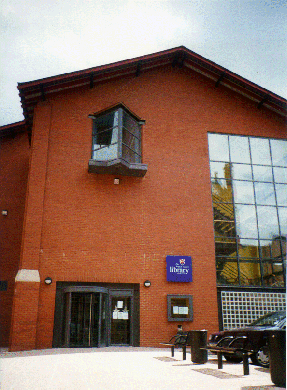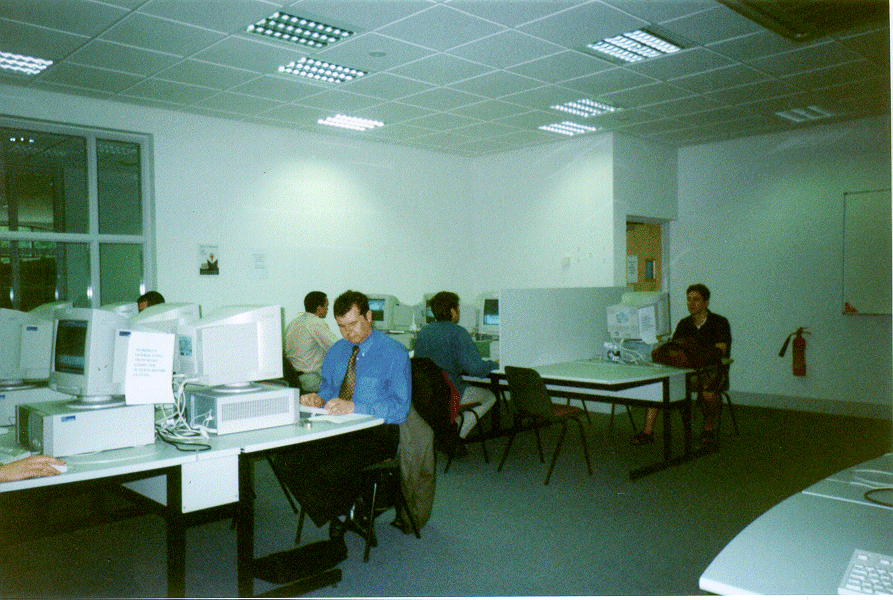Down Your Way: Queen's University Library
Sunday 6 July, the Royal Ulster Constabulary was under attack on the Lower Ormeau Road, Belfast. The following day, less than a mile away, the RUC band was playing at the Graduation Garden Party at The Queen’s University of Belfast. The contrast between the conservation area of the Victorian university and the squat red-brick terraces of the Lower Ormeau Road could not be greater, yet they are both typical, in their own way, of life in the province. Although Lower Ormeau Road tends to dominate the news coverage, Queen’s has much to offer, and I was determined to find out what it was, with Associate Librarian Trevor Lyttle as my guide.
University Library [1] has expanded greatly from its origins in the Main Library, now a Grade 1 listed building, and there are seven branch libraries spread throughout the city. Like most universities, Queen’s has had to absorb a large increase in student numbers – 40% since 1990 – and has adapted its academic year to semesterisation. The Library has tried to deal with this by means of an action plan which has been driven by the results from surveys of academics and students. Overall there is a high satisfaction level, but one major weakness stands out – availability of required reading material.

Access to the library building has been a critical problem. Pressure on the Main Library in the mid-1990s was severe, with queues frequently stretching out of the building into the old quad in busy periods due to the fire regulations which only allowed 600 users in the building at any one time. The pressure was relieved this January, when a new purpose-built undergraduate library, the Seamus Heaney Library [2] (see picture, left), was opened to users on the main campus. Inevitably, the Library was built with funding made available as a result of the Follett Report of 1993.
The Library combines quiet reading areas and computing facilities, housing 20,000 volumes and 20,000 off-prints. The book collections are kept in ‘steady state’. Since its opening, the Library has been well used, with an average of 4,000 users through the entrance on a mid-term weekday. A new card-based entrance and exit system in which users must swipe themselves in and out, provides the Library with very accurate management information.
In addition to the problem of accessibility of the bookstock, Queen’s has suffered badly in recent years from the common problem of late notification of reading list material. The Library was frequently in the position of not knowing what was required reading until after courses had begun. Tackling this required a culture change on the part of academics. Library staff always knew that it was going to be difficult to persuade academics to take on ‘extra’ work, as Law Librarian Miriam Dudley explained.
“We set up a working party in early 1996, which designed a standard form for submission of reading lists [3]. This relieved academics of the burden of completing proposal cards for each text.” This form was made available in both electronic and paper formats. Reactions from staff to the reading lists project have tended to divide along discipline lines. Academics in the sciences have tended to be more accepting than those in the arts and humanities.
“Some reading lists do still turn up unexpectedly at enquiry desks, having evaded the new system, but we have developed a fast-track procedure designed to get the books onto the shelves within a week, if possible.” The working party is scheduled to continue until Christmas 1997 at which point it is hoped the project can enter a maintenance phase and be handed over to the Acquisitions Department. With the introduction of the new BLCMP TALIS reading list module, access to the reading lists should soon be available from the Web OPAC.

Even in the Long Vacation, an Open Access Computer Room in the Seamus Heaney Library is busy
Network-based services have brought enormous gains to Queen’s, but not cost-free. Staff training is an obvious expense and new posts have been created to help train staff and produce documentation. According to University Librarian Norman Russell, there has been a huge development in staff expertise. “Network technologies came to the fore in 1995 when the Library faced a periodicals budget crisis and had to make cuts. We asked academic staff to identify the most-used journals in support of teaching as well as for research. It made an enormous impact to the way journal articles are used in this university.” The result was a staggering 45% saving in the periodicals budget. Although journal reductions are never popular, the Library offered electronic information retrieval, interlibrary loan and document delivery systems in their place – the now familiar holdings-to-access switch. It has paid off.
The university is one of the pilot sites feeding into the JISC project to develop guidelines for institutions wishing to develop an information strategy. Queen’s’ approach is not driven solely by the Library or the Computer Centre but by expertise obtained from across the entire university. This links information closely to teaching and learning. All academic departments are involved, with academics from the School of Management taking a leading role. When the pilot sites report in the autumn, the approach taken by Queen’s, stressing the importance of information at the centre of the learning process, will reveal a fascinating combination of new techniques in the service of the traditional role of the university as a place of learning. It is an approach symbolised by the handsome new Seamus Heaney Library which stands proudly at the heart of the elegant Victorian campus.
References
[1] Queen’s University of Belfast Library
http://web.qub.ac.uk/lib/
[2] Seamus Heaney Library
http://web.qub.ac.uk/lib/wherelib/shl/shl.html
[3] Reading List Project
http://www.qub.ac.uk/lib/reading/reqread.html
Author details
Isobel Stark,Web Officer,
UKOLN,
University of Bath,
Bath, BA2 7AY
email:i.a.stark@ukoln.ac.uk
